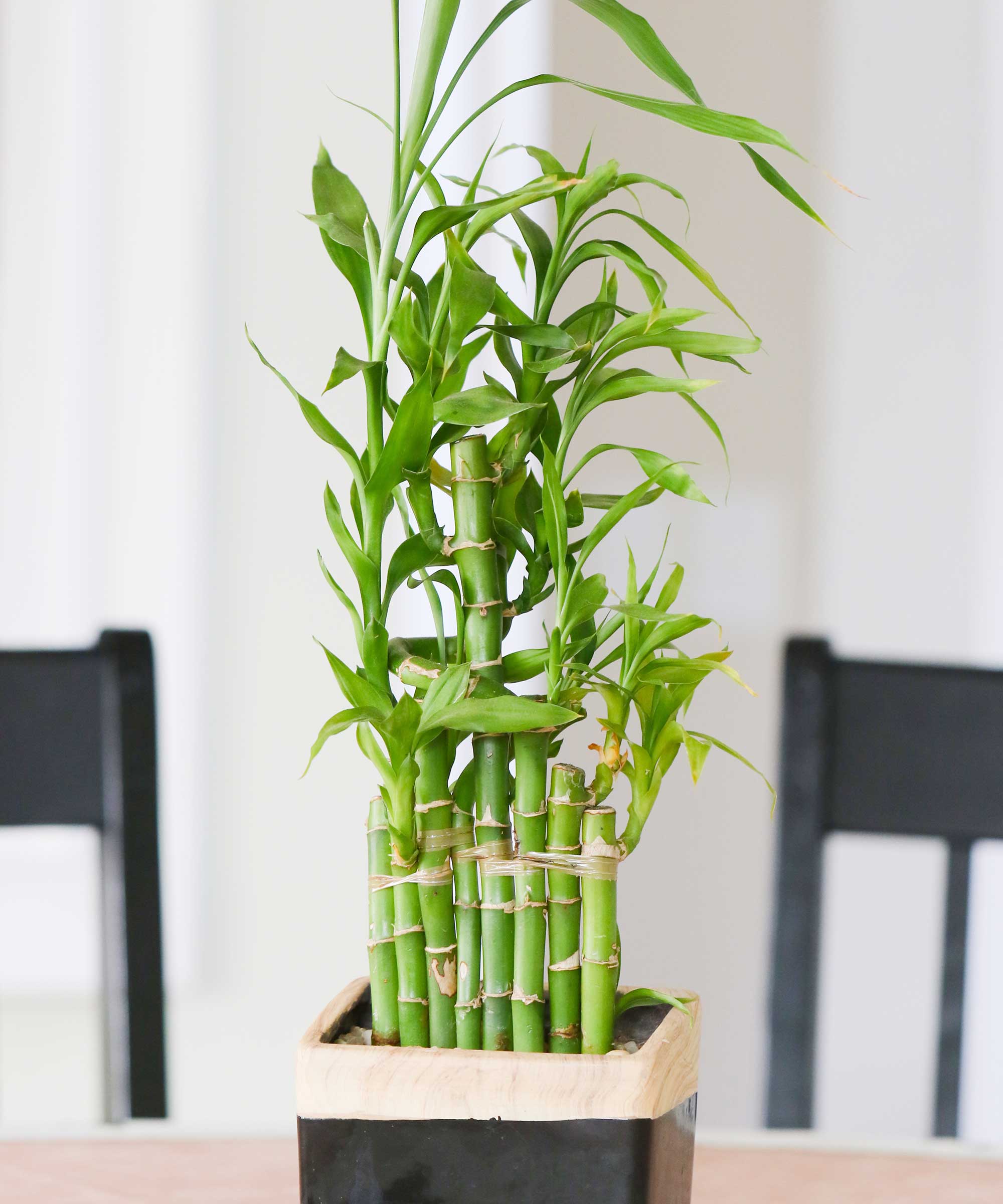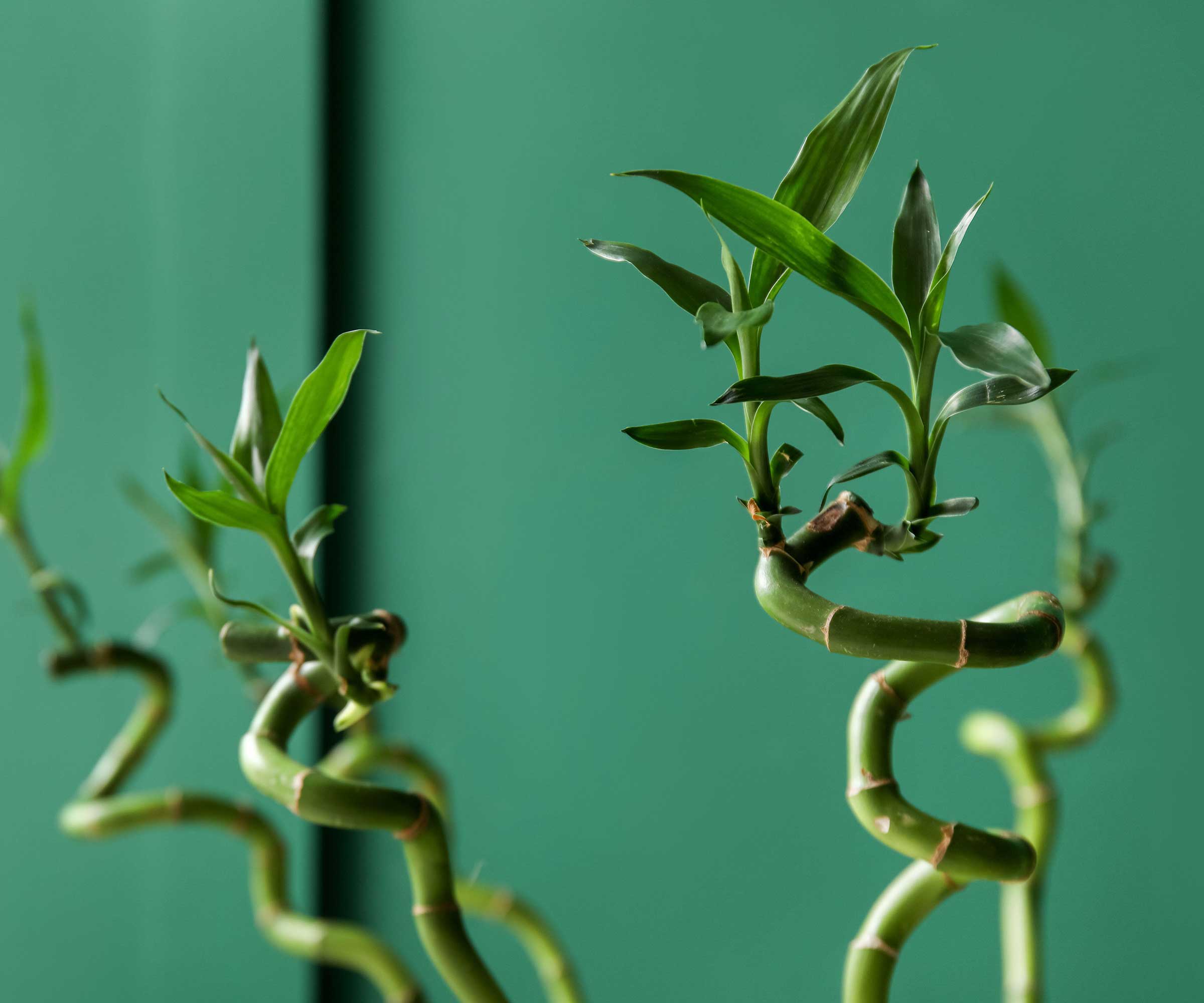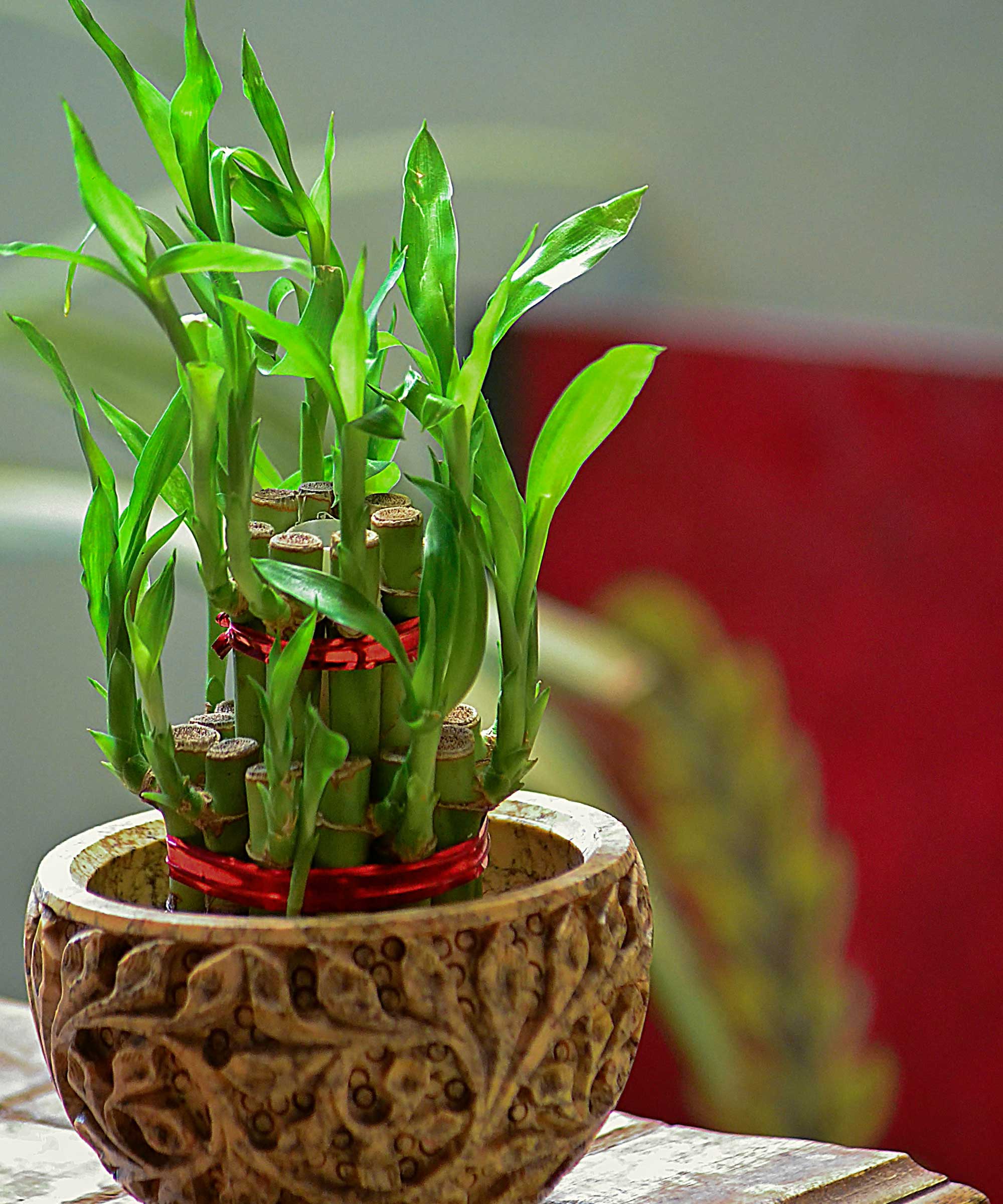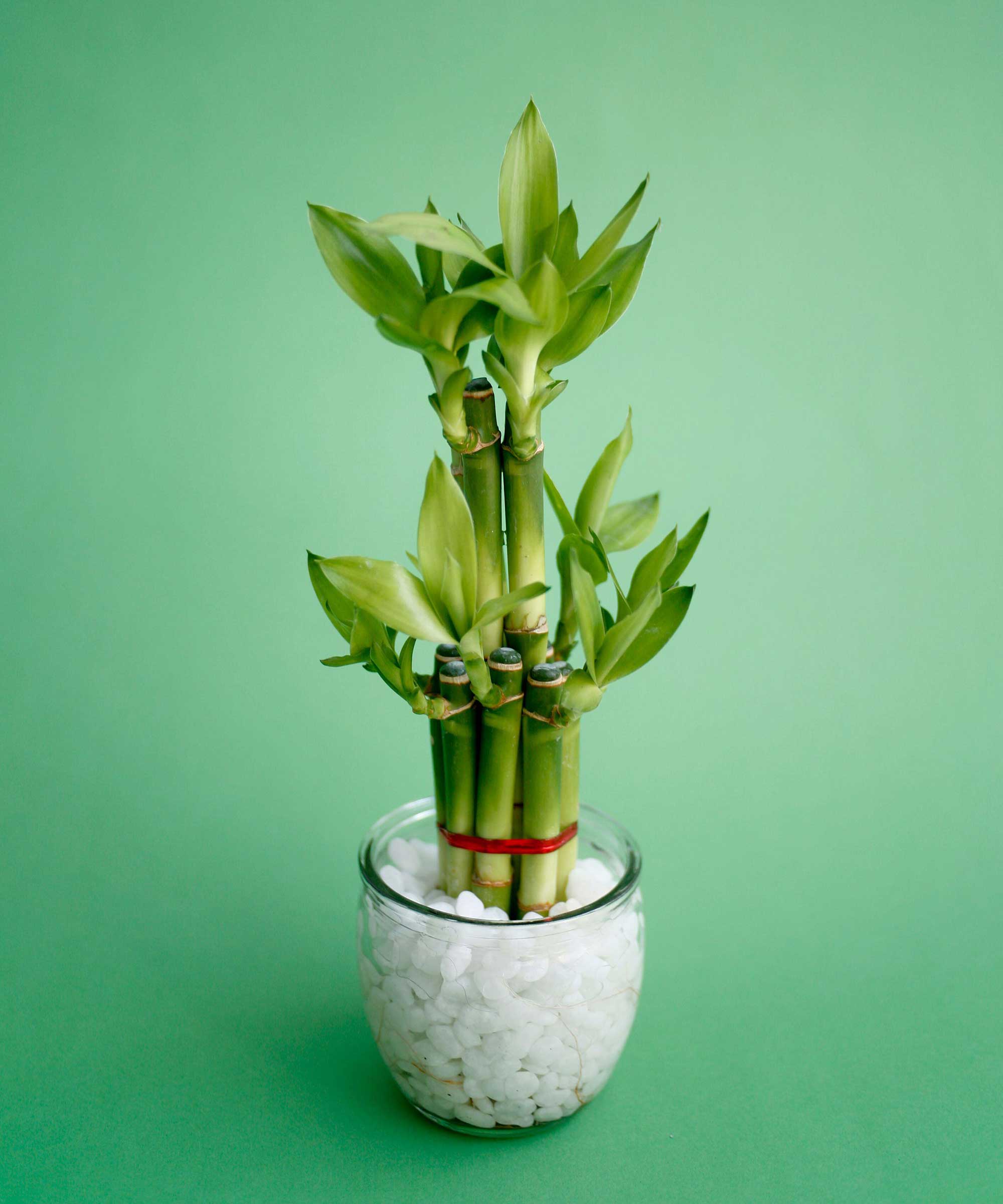
Q: I was given a lucky bamboo as a gift, and have had it for a year or so. It's currently planted in a small, shallow pot in soil, and the roots have started to emerge. Is it a good idea to repot it, and if so, how should I go about it?
A: Lucky bamboos – which aren't actually true bamboos but members of the Dracaena family – are one of the easiest indoor plants to care for. But, after a while, they can start to outgrow their original pot. Congested roots can make it more difficult for them to get the nutrients they need, so it's worth providing a more spacious home.

How to repot a lucky bamboo
Keep your houseplant happy with this advice.

When to repot lucky bamboo
Repotting lucky bamboo is typically done every one or two years, or when you notice that the roots are growing out of the container, says Kayla Gajdascz of Mental Houseplants. There are other telltale signs that a repotting is in order, too. These include a slower growth rate than usual, a visible salt and mineral build-up on the plant or pot, if the frequency of watering has had to be increased, or if the plant has become top-heavy and tips over easily, she lists.
'The best time to do this is in the spring, as the warmer temperatures and increased daylight support the plant's recovery and new growth,' says gardening expert Tony O'Neill.

A step-by-step guide to moving your lucky bamboo into a new pot
'Repotting rejuvenates your bamboo, providing fresh nutrients and room to grow,' says Tony. 'It also helps prevent root rot and other diseases due to overcrowded conditions.'
The process is simple:
- 'Select a pot that is 1-2 inches larger in diameter than the current one,' says Kayla. 'Too large a pot can lead to overwatering issues. Of course, ensure the pot has drainage holes.'
- Place a layer of well-draining potting mix at the bottom of the new pot, Kayla continues. Plant expert Autumn Hilliard-Knapp suggests combining peat moss with perlite (available from Perfect Plants Nursery) or sand.
- 'Gently take the plant out of its current pot,' Kayla says. 'You might need to tap the pot's sides or bottom to loosen the soil.' Autumn suggests moistening the soil or using a clean tool to help remove it if the plant is tightly rooted.
- 'Inspect the roots and trim any that are dead or overly long,' Kayla says. 'If the roots are tightly wound, gently tease them apart.'
- 'Set the plant in the new pot and fill around it with potting mix,' Kayla says. 'The top of the root ball should be just below the rim of the pot.' Ensure the bamboo is upright and stable, Autumn says. Gently patting down the soil can help with this, but don't compact the soil too much, she warns, as this can prevent proper drainage.
- 'Water the plant thoroughly after repotting,' Kayla continues. 'This helps settle the soil around the roots.'
After repotting your lucky bamboo, Kayla recommends keeping the soil consistently moist but not waterlogged. 'Water when the top two inches of soil dries out,' she says. You can also apply a balanced, water-soluble fertilizer every 4-6 weeks during the growing season, she adds.
Bright, indirect light should also be provided. 'Avoid direct sunlight, which can scorch the leaves.'
Top tip: If you wish, you can also take the opportunity to propagate your lucky bamboo as you repot it. Carefully split apart well-rooted sections and plant them separately.

Transplanting a lucky bamboo growing in water to a new container
Lucky bamboo can be grown successfully in containers of filtered water or harvested rainwater, sometimes alongside small pebbles. If you want to give it a fresh container after a while, follow these steps:
- Remove the bamboo from its current container. 'Trim any brown or mushy roots with sterile shears,' Autumn says.
- Then, she instructs carefully placing the remaining healthy roots in the new container and filling it with clean water – 'enough to cover the roots completely.'
- Adjust the position of the bamboo in the water-filled container to stabilize it, she says. 'Maintain a consistent water level, changing it every two weeks to prevent stagnation.'

Transplanting a lucky bamboo from water to soil
Moving a lucky bamboo growing in water into a container with soil can help it to live longer.
The process is more or less the same as repotting them from soil. Gently remove the plant, then plant it into a moist potting mix. Keep it well-watered at first. The plant may struggle a bit as it recovers from transplantation shock, but it should soon return to full health with the right care.

FAQs
How long do lucky bamboos live for?
In water, lucky bamboos only live for a couple of years. But, when planted in soil, they can live for many years if they're provided with the right growing conditions.
Do you need to repot other types of indoor bamboo?
As mentioned, lucky bamboo isn't actually a type of bamboo. And although real bamboo varieties are generally grown as outdoor plants, many plant enthusiasts grow them successfully indoors, as houseplant expert Vladan Nikolic points out.
For instance, dwarf greenstripe bamboo is often grown indoors. 'It’s especially popular due to its compact size and captivating striped foliage,' Vladan says.
If your plant becomes rootbound (the roots are poking out of the drainage holes), it's time to repot, he says. The process is similar to repotting lucky bamboo – except you are likely to need a larger pot to accommodate the plant.
'Water your bamboo well one day before repotting. Watering will help the plant slide out of the old container more easily,' he says. 'Use well-draining, and neutral to slightly acidic soil. Although bamboo can adapt well to different soils, they thrive in this soil type.'
Lucky bamboo is ideal for adding a touch of Feng Shui to your space, whether that's in the bedroom or the bathroom. And with these repotting tips, you can keep it looking its best throughout the year.







